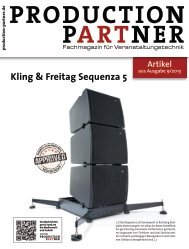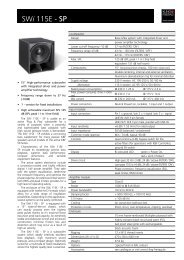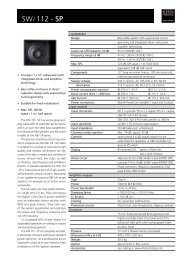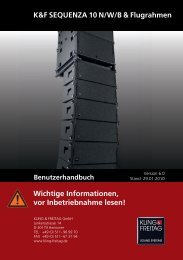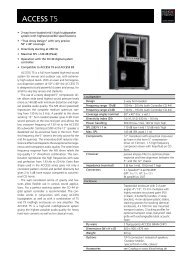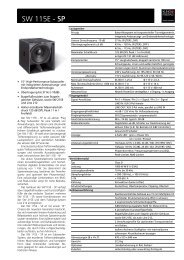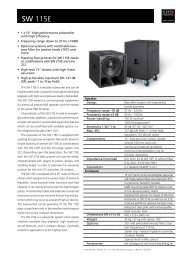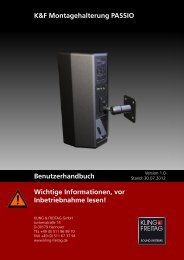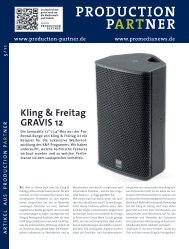User's Manual - Kling & Freitag
User's Manual - Kling & Freitag
User's Manual - Kling & Freitag
Create successful ePaper yourself
Turn your PDF publications into a flip-book with our unique Google optimized e-Paper software.
User’s <strong>Manual</strong> CA 205<br />
6. Mounting Instructions for Loudspeakers<br />
Mount the speakers securely. To avoid injury or damage, always be sure to mount the<br />
speakers securely so that they do not fall. Speakers, which are stacked, must be secured<br />
with securing straps. When laying the connecting cables, make sure that nobody<br />
can trip.<br />
The stability of stacked systems (also valid for the use of stands and distance rods!) is<br />
contingent upon the following stability requirement. These conditions must, therefore,<br />
be guaranteed by the user:<br />
Stacked systems may not fall over even if they are inclined by 10° in each direc-<br />
tion. If this requirement is not fulfilled, then it is necessary to take steps to<br />
achieve compliance. Possible measures include strapping it to an appropriate<br />
base structure or fastening it using safety straps.<br />
Warning<br />
6.1 Proper Arrangement of the Loudspeakers<br />
Be aware of the fact that the logical targeted alignment of this high quality speaker<br />
system can lead to a significant qualitative increase in the acoustic result. It is not<br />
possible to make generalities about the alignment of specific systems because the<br />
room has a substantial influence on the signal and the audible result.<br />
As a rule, the mid- and high-transducers of loudspeakers should be mounted above<br />
the audience's face value, so that the sound distribution cannot be shadowed.<br />
In many cases it is advisable to mount a loudspeaker higher, so that the sound will be<br />
distributed throughout the room more evenly. Low standing systems result in a<br />
greater difference in volume between front and back seats than higher standing system.<br />
Please note that this is only a general guideline and the best possible result may vary<br />
from room to room.<br />
To simulate the correct alignment of the speakers beforehand, there are various programs<br />
such as ‘Ease’ or ‘Ulysses’. The <strong>Kling</strong> & <strong>Freitag</strong> speaker system data is available<br />
for download on our website www.kling-freitag.d.<br />
The following graphics will assist in making a rough estimate as to the distance range<br />
of the CA 205. The graphics only take into consideration the sum of the direct sound<br />
and not the influence of the room. Because of this there can, in some cases, be noticeable<br />
deviation.<br />
Distance range of SPL (direct sound level):<br />
-12 dB<br />
-6 dB<br />
0 dB<br />
-18 dB<br />
-24 dB -30 dB<br />
-34 dB<br />
2m 4m 8m 16m 32m 50m<br />
KLING & FREITAG GMBH ©1995-2005 Version 3.1, 08.11.2006 Page 10 of 22



